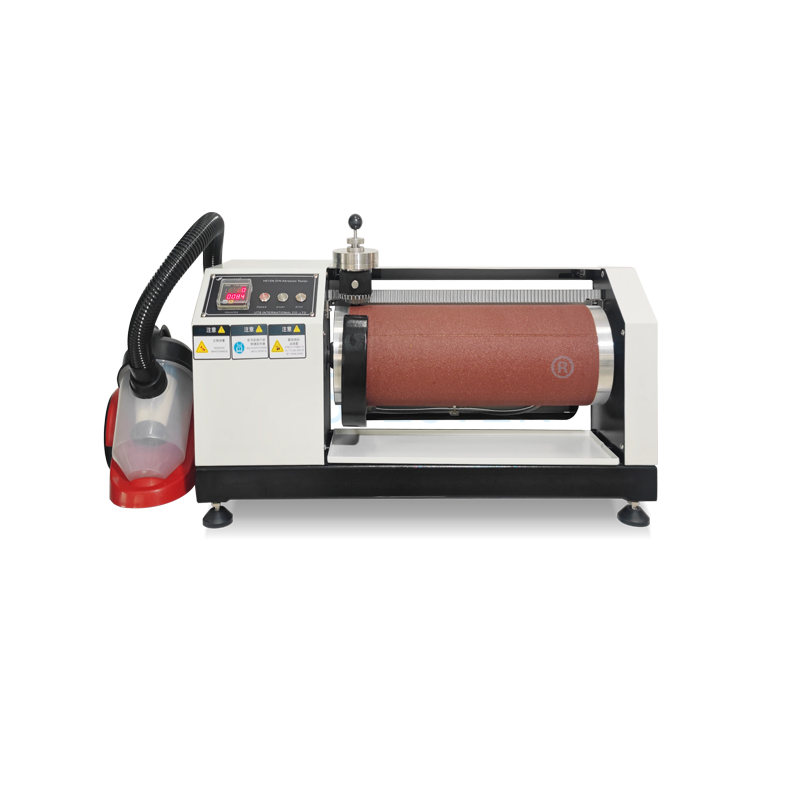 +86 152 6060 5085
+86 152 6060 5085
 +86 152 6060 5085
+86 152 6060 5085
Blog
Catalog
Latest Blog
My country's current standard for leather shoe heels QB/T 3643-1999 "Leather Heel Surface" stipulates the wear resistance of the leather shoe heel surface using the standard method of GB/T 3903.2-1994 "General Inspection Methods for Footwear Wear Resistance Test Methods" However, in actual operation, some materials (especially the heel surfaces of women's shoes) tested using the national standard method cannot produce wear marks under the gears or the wear marks are unclear, so quantitative results cannot be obtained.
A.Commonly used wear resistance testing methods
At present, the wear resistance testing of sole materials usually includes GB/T 3903.2-2008 "General test methods for wear resistance of footwear", GB/T 9867-2008 "Wear resistance of vulcanized rubber or thermoplastic rubber" Determination of performance (rotating roller abrasion machine method)", GB/T1689-1998 "Determination of abrasion resistance of vulcanized rubber (using Akron abrasion machine)", ASTM D1630-2006 "Abrasion performance of NBS rubber" and by many companies and 5 test methods including the Dongguan Hengyu Instrument Company's Tianpi Wear Resistance Test Method adopted by the quality inspection department. Among them, GB/T1689-1998 "Determination of the Wear Resistance of Vulcanized Rubber (Using Akron Abrasion Machine)" is applicable to vulcanized rubber and is not applicable to plastic and polyurethane materials currently widely used in women's shoe soles. The ASTM D1630-2006 "NBS Rubber Wear Properties" method requires a large sample size, which cannot be reached by many women's shoe heel areas, and requires a flat surface of the sample. It is difficult for general shoe soles to meet the requirements, so this method is not suitable. Wear resistance test of heel surface materials. The other three methods are theoretically feasible to test the wear resistance of leather heel surfaces, but the specific results require further experiments.
B.Experimental method
Use different test methods to conduct wear resistance experiments on three types of heel surface materials. Comparatively analyze the test results and select a testing method for heel surface materials with the widest applicability. Then use the selected method to conduct a physical test on the wear resistance of the designated heel surface material. At the same time, use the same material to make the heel surface of the shoe for a try-on experiment, and compare the physical test results with the actual try-on results. To verify the feasibility and accuracy of the test method.
1. Comparison of different testing methods
(1) Tested using GB/T 3903.2-2008 "General Test Methods for Wear Resistance of Footwear". Test principle: The rotating grinding wheel presses vertically on the sample, performs a wear test on the sample under specific conditions, and measures the wear mark length of the sample to indicate the wear resistance of the sample.
(2) Tested using GB/T 9867-2008 "Determination of Wear Resistance of Vulcanized Rubber or Thermoplastic Rubber (Rotating Roller Abrasion Machine Method)". Test principle: Under the specified contact pressure and a certain area, measure the amount of wear caused by friction of a cylindrical sample on a certain level of gauze and within a certain distance.
(3) The test was conducted using the Tianpi Wear Resistance Test Method "Tianpi Wear Resistance Testing Implementation Rules" of Dongguan Hengyu Instrument Company. Test principle: Place the leather heel surface material on sandpaper, rub it under the specified load and number of frictions, and measure its wear thickness.
2. Validation of selected test methods
(1) The physical test experiment uses the wear resistance test method of the heel surface material selected in the previous step of the experiment, conducts the wear resistance test on 7 different materials of the heel surface material, and records the results.
(2) Try-on experiment Use the same 7 heel surface materials as the above-mentioned physical test experiments to make the heel surface of the finished shoe, and conduct a try-on experiment on the finished shoe. The heel surfaces of three kinds of materials were installed on women's shoes of the same style to make 12 pairs of shoes, which were worn by 4 female testers with standard foot types. Each tester tried on 3 pairs of women's shoes with different heel surface materials. In addition, 4 pairs of men's shoes are made of 4 different heel materials, each with a standard foot shape for special environments such as travel. Male tester tries on. The trial period is 2 months, during which each pair of shoes is worn in rotation. The try-on environment is daily life environment, including daily work, home, going out, etc., excluding sports,
(2) Comparison of physical test results and try-on experiments Compare the physical test results with the results of the try-on experiments to verify the feasibility and accuracy of using the selected test method to test the wear resistance of heel surface materials.
C.Conclusion
By comparing the physical property test results of several testing methods and comparing them with the test results, it can be seen that GB/T9867-2008 "Measurement and control of the wear resistance of vulcanized rubber or thermoplastic rubber provides guidance. The fixed (rotating roller abrasion machine method) method is suitable for testing a variety of leather heel surface materials. The results of this research can provide a basis for formulating relevant method standards and improve the quality of enterprises' actual production.

Email: hello@utstesters.com
Direct: + 86 152 6060 5085
Tel: +86-596-7686689
Web: www.utstesters.com